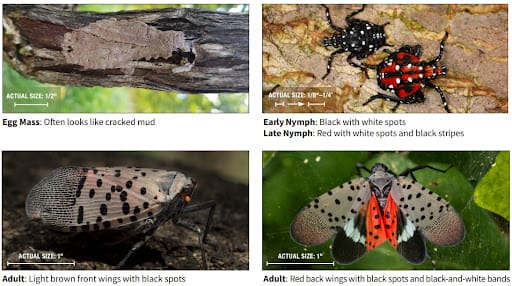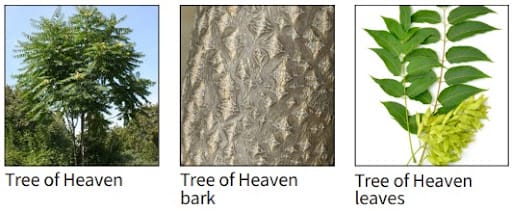
By Laura Boaggio, contributor
Julie Hart, who lives in Rockingham County, was visiting Smiley’s Ice Cream in Bridgewater with her family in early October after hiking a trail in Shenandoah National Park when her daughter noticed a bright red speck on the ground.
“Isn’t that one of the bad bugs from that poster we saw on our hike?” her daughter asked.
Sure enough, it was one of the insects prominently featured on the warning poster at the trailhead. And that bug — the spotted lanternfly — didn’t warrant a giant mugshot for its pretty appearance.
The Virginia Department of Agriculture and Consumer Services detected its first spotted lanternfly in Harrisonburg a year ago, said David Gianino, program manager for the Virginia Department of Agriculture’s Consumer Services Office of Plant Industry Services.
The species is native to China and notable for its spotted wings and striking red color. It first popped up in the U.S. in September 2014, when it was first reported in Pennsylvania. The first sighting in Virginia was on Jan. 10, 2018, according to the Virginia Cooperative Extension.
Over the last year, they’ve now made their way to over 30 localities in the state, including Harrisonburg, Rockingham, Augusta, Page, Shenandoah and Albemarle counties.
And their most intrusive quality is related to their sweet tooth.
The Virginia Department of Wildlife Resources compares the spotted lanternfly to vampires on its website – and for good reason. The lanternfly likes to feed on fruit and certain tree species.
By feeding on them, they steal nutrients from the plant and can let in secondary diseases and infections, said Wesley Runion, Harrisonburg Environmental Specialist.
“It’s like death by a thousand cuts,” Runion said.
The uptick in lanternfly numbers is dangerous because the bugs like to group feed, Gianino said. They gather on a tree or vine to suck out the sap, which has nutrients, water, vitamins and sugars.
While feeding, lanternflies also secrete a sticky substance called honeydew, which attracts sugar-loving insects and promotes the growth of black sooty mold, according to Penn State Extension.
Like many invasive species, the spotted lanternfly has no natural predators in the U.S. – which means it’s up to the public to stop the spread.
So when the Harts saw the lanternfly on the ground in Bridgewater, Julie Hart’s husband smashed it.
Stopping the spread
The insect’s spread has led to hotspots across the Valley, including some unexpected places. For instance, it seems the pests have figured out how to traverse mountains. A recent hotspot in the Massanutten mountain and resort area likely spread from the town of Shenandoah, Gianino said.
This took the department by surprise because environmental specialists didn’t think the bugs could handle the elevation of that journey.
Virginia Department of Agriculture and Consumer Services in July 2022 established both Rockingham County and the city of Harrisonburg as quarantine areas, which means there are multiple reported populations of lanternflies reproducing.
Environmental officials encourage people in a quarantine zone to check their vehicles and any outdoor items they might transport. Businesses in quarantine areas must obtain a permit from the Virginia Department of Agriculture and Consumer Services and inspect all regulated items leaving their zone to ensure they don’t contain lanternflies.
That’s because while these sap-suckers can fly, it’s not their wings that have taken them so far — but rather their hitchhiking abilities.
Human transportation is the lanternflies’ preferred mode of long-distance travel and the main reason why populations haven’t been contained, according to the Cornell College of Agriculture and Life Sciences.
“That bug will stay on the car or on the vehicle for up to 50, 60 mph,” Gianino said. “It’s good at finding places to hide and places to hold on to.”
Not only do adult lanternflies hitch a ride, but females like to lay their egg masses, which contain around 35-50 eggs, on vehicles too, Gianino said.
“It’s those long routes that can take an egg mass from Northern Virginia and have it in Southern Virginia today,” Runion said.
An effective way to prevent the spread is by smashing egg masses before they hatch and multiply, Runion said.
And this is the season for that.
Fall is when spotted lanternflies reproduce – the Virginia Department of Agriculture and Consumer Services found its first spotted lanternfly egg mass in late September, Gianino said. The bugs will continue laying eggs until the first frost slows down their reproduction. Around mid-November adult lanternflies will start to die, while egg masses stay dormant throughout the winter until they hatch in the spring.

Populations have spread rampantly down from Frederick County, where they were first reported in Virginia, Gianino said. They seem to be spreading locally along interstates, highways and railroads – anywhere with human activity and travel.
The first lanternfly sighting was reported on James Madison University grounds, he added.
There’s now a handful of hotspots surrounding James Madison University, Gianino said, often adjacent to the railroad.
“Honestly any area that’s near that Norfolk Southern rail line, you’re going to probably start seeing spotted lanternflies,” Gianino said.
Campaigning for squishing
While lanternfly sightings might seem to be increasing, so is awareness, Runion said
“People are recognizing these things and starting to see them,” he said.
Just as Hart’s daughter recognized the lanternfly at Smiley’s, environmental agencies, national parks and local groups across the region are spreading a similar message through social media and fliers: ‘See it? Squish it!’
Melissa Black Nguyen, owner of Great.Full Goods, recently spotted one outside of Agora Downtown Market in Harrisonburg. A guest vendor thought the bug was pretty and took a picture before realizing what it was. After confirming with Nguyen, she quickly squashed it.
Since the county is in a quarantine zone, people don’t need to report sightings to the Virginia Department of Agriculture and Consumer Services anymore, Gianino said.
What folks can do is kill one on sight and check their vehicles for any when traveling outside the county. Particularly the windshield wipers, which is where nymphs and adults like to hang out, Gianino said.
It’s especially important to sweep a vehicle if it’s been sitting under a tree-of-heaven, which is their preferred meal.

Tree-of-heaven, or alianthus altissima, is also highly invasive throughout the U.S. — especially in Rockingham County, Runion said.
“It just gives us a little bit more motivation to kill that Alianthus,” he said.
Keeping watch over crops
While eradicating tree-of-heaven could slow the lanternflies’s spread, some farmers are taking it a step further.
Because the pest can harm agritourism, vineyard and orchard farmers, like Lee Hartman of Bluestone Vineyard, have kept a close eye on their crops.
While Hartman said he hasn’t seen any lanternflies on his property, he’s had years to prepare by learning from farms hit harder by the pest, like in Pennsylvania, he said.
One method some farmers use is to keep a tree-of-heaven alive on the property to attract the lanternflies, almost like a moth to a light, Hartman said. Channeling the bugs into one area makes them easier to kill.
Hartman’s primary prevention method for any bug pest is to inspect his crops and trees routinely, he said.
Local farmers have been open with each other about lanternfly sightings, Hartford said. Honesty is important so they don’t accidentally spread the pest while visiting each other.
While farmers have a laundry list of pests to deal with, lanternflies are different because of the section of crop they attack, Hartman said.
While other pests eat the canopy or fruit, which would affect a single season, the lanternfly damages the trunk, which could take out the whole plant and leave a farmer crop-less for multiple seasons.
“It takes years from the time you plant to your first harvest,” Hartman said.
Dominique Abbrescia and her husband, who live in Lacey Spring, found and smushed a cluster of about 10 lanternflies while clearing out brush on their property, she said. Abbrescia said they assumed the bugs like tree-of-heaven, as it’s the only species in their section of the woods.
Marcy Holbert, who lives outside Elkton, said she couldn’t keep up with squishing all the ones she found in her yard this summer. They definitely like her grape vine, she said.
A nuisance in many ways
Aside from the damage they cause the agritourism industry, spotted lanternflies are a significant nuisance in other ways. In areas where the spotted lanternfly populations are high, such as Frederick County and the cities of Winchester and Lynchburg, the swarms have started to impact people’s quality of life, Gianino said.
“When you have a sporting event or you have a barbecue on your back porch, it kind of impacts all people when you have about 200-300 bugs flying around your head,” Gianino said.
And native trees aren’t adjusting to the swarms, Runion said.
Because spotted lanternflies are also fond of trees like maple and black walnut, Harrisonburg is concerned with losing tree canopy coverage. Especially since it’s already battling the emerald ash borer, an invasive beetle that kills ash trees, Runion said.
That’s why the public campaign asks people to kill the ones they see, although doing so meas being quick, Runion said. When he tried to grab one in Warren County, the bug acted like a leafhopper and sprung away.
“I tried to get it and it just took off,” he said.
Thanks for reading The Citizen, which won the Virginia Press Association’s 2022 News Sweepstakes award as the top online news site in Virginia. We’re independent. We’re local. We pay our contributors, and the money you give goes directly to the reporting. No overhead. No printing costs. Just facts, stories and context. We value your support.














